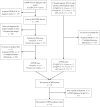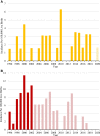Diagnosis and Incidence of Congenital Combined Pituitary Hormone Deficiency in Denmark-A National Observational Study
- PMID: 37043518
- PMCID: PMC10505542
- DOI: 10.1210/clinem/dgad198
Diagnosis and Incidence of Congenital Combined Pituitary Hormone Deficiency in Denmark-A National Observational Study
Abstract
Context: Congenital combined pituitary hormone deficiency (cCPHD) is the loss of ≥2 pituitary hormones caused by congenital factors.
Objective: We aimed to estimate the national incidence of cCPHD diagnosed before age 18 years and in subgroups.
Methods: Patients with cCPHD were identified in the Danish National Patient Registry and Danish hospital registries in the period 1996-2020. Hospital files were reviewed and incidences calculated using background population data. Incidence was the main outcome measure.
Results: We identified 128 patients with cCPHD; 88 (68.8%) were males. The median (range) age at diagnosis was 6.2 (0.01-19.0) years. The median (25th;75th percentile) number of hormone deficiencies at diagnosis was 3 (3; 4) at <1 year vs 2 (2; 2) at 1-17 years, P < .0001. Abnormal pituitary magnetic resonance imaging findings were seen in 70.3% (83/118). For those born in Denmark aged <18 years at diagnosis (n = 116/128) the estimated national incidence (95% CI) of cCPHD was 10.34 (7.79-13.72) per 100 000 births, with an annual incidence rate of 5.74 (4.33-7.62) per million. In subgroup analysis (diagnosis <1 vs 1-17 years), the incidence was highest in the 1-17 years subgroup, 7.97 (5.77-11.00) vs 1.98 (1.39-2.84) per 100 000 births, whereas the annual incidence rate was highest at <1 year, 19.8 (13.9-28.4) vs 4.69 (3.39-6.47) per million births.
Conclusion: cCPHD had the highest incidence rate and the most hormone deficiencies in those diagnosed at <1 year. The incidence was highest in the 1-17 years age group, underscoring the need for multiple pituitary hormone investigations throughout childhood and adolescence in children with only 1 hormone deficiency.
Trial registration: ClinicalTrials.gov NCT05334563.
Keywords: cCPHD; cMPHD; congenital combined pituitary hormone deficiency; congenital hypopituitarism; diagnosis of hypopituitarism; incidence.
© The Author(s) 2023. Published by Oxford University Press on behalf of the Endocrine Society.
Figures




References
-
- Romero CJ, Pine-Twaddell E, Radovick S. Novel mutations associated with combined pituitary hormone deficiency. J Mol Endocrinol. 2011;46(3):R93‐R102. - PubMed
-
- Haim-Pinhas H, Kauli R, Lilos P, Laron Z. Growth, development, puberty and adult height of patients with congenital multiple pituitary hormone deficiencies. Growth Horm IGF Res. 2016;27:46‐52. - PubMed
-
- Cerbone M, Dattani MT. Progression from isolated growth hormone deficiency to combined pituitary hormone deficiency. Growth Horm IGF Res. 2017;37:19‐25. - PubMed
-
- Di Iorgi N, Morana G, Allegri AE, et al. . Classical and non-classical causes of GH deficiency in the paediatric age. Best Pract Res Clin Endocrinol Metab. 2016;30(6):705‐736. - PubMed

